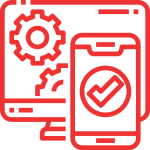About Us
BRAND IDENTITY | DIGITAL MARKETING | WEB SOLUTIONS
OUR Performance
Your Partner For IT & Business Solution
BRAND IDENTITY | DIGITAL MARKETING | WEB SOLUTIONS
At Nubicus, we’re experts in web design, development, and digital solutions. We create outstanding online experiences, offer services like digital marketing and branding, and help businesses thrive in the digital world. Our team excels in building visually appealing and technically strong websites, leaving a lasting impact on your audience.
Whether you need a strong online presence or want to boost business growth, Nubicus is your trusted partner for success. Our IT services combine industry knowledge with cutting-edge technology to tailor solutions for your needs, whether it’s streamlining operations, increasing productivity, or expanding online reach.
OUR BENEFITS
Why Choose Us?
Choose Nubicus for your company’s needs because we combine knowledge, creativity, and a dedication to producing outstanding results.

Digital Experience
Modern digital experience elements offered by Nubicus improve user interactions, maximise engagement, and support seamless online experiences for enterprises.

App Development
Innovative and user-friendly mobile applications are created using cutting-edge technologies and industry best practises by Nubicus, which offers amazing app development features.

Business Planning
Nubicus offers comprehensive business planning features to define goals, analyze markets, develop strategies, and create roadmaps for success and growth.
OUR BENEFITS
Brand Identity
Brand identity refers to the collection of visual elements, messaging, and other components that distinguish a brand in the minds of consumers and differentiate it from competitors. It encompasses various tangible and intangible elements that together convey the brand’s personality, values, and purpose. Here are some key components of brand identity:
Logo: The logo is often the most recognizable element of a brand’s identity. It is a graphical representation of the brand and should be simple, memorable, and reflective of the brand’s personality and values.
Color Palette: Colors play a crucial role in conveying emotions and associations. A consistent color palette across all brand materials helps reinforce brand recognition and evoke specific feelings or perceptions.
Typography: Typography refers to the fonts and typography styles used in brand communications. Consistent typography reinforces brand consistency and helps establish a brand’s tone and personality.
Visual Elements: Beyond the logo, visual elements such as icons, illustrations, patterns, and photography style contribute to the overall brand identity. These elements should align with the brand’s aesthetic and messaging.
Brand Voice and Tone: The brand voice refers to the personality and style of communication used in brand messaging. It includes aspects such as language, tone, and messaging style, which should be consistent across all touchpoints.
Mission, Vision, and Values: Clearly defined mission, vision, and values statements articulate the brand’s purpose, aspirations, and guiding principles. They serve as a foundation for brand identity and help shape messaging and positioning.
Brand Story: A compelling brand story helps consumers connect with the brand on a deeper level by communicating its history, values, and unique selling proposition. It humanizes the brand and fosters emotional engagement.
Brand Guidelines: Brand guidelines document the rules and standards for using brand elements consistently across different channels and materials. They ensure brand coherence and provide guidance for internal and external stakeholders.
Packaging and Product Design: For consumer goods brands, packaging and product design are essential elements of brand identity. They influence consumers’ perceptions and play a significant role in brand recognition and differentiation.
- Brand Experience: Every interaction a customer has with the brand, whether through products, services, customer support, or marketing touchpoints, contributes to the overall brand experience. Consistent delivery of positive experiences reinforces brand identity and fosters loyalty.
Digital Marketing
Creating a strong and cohesive brand identity involves careful planning, creative execution, and ongoing management to ensure consistency and alignment with the brand’s objectives and values. It’s a dynamic process that evolves over time as the brand grows and adapts to changing market conditions and consumer preferences.
Digital marketing encompasses a broad range of online marketing activities aimed at promoting products, services, or brands using digital channels. Here’s an overview of some common digital marketing strategies:
Search Engine Optimization (SEO): SEO involves optimizing your website to rank higher in search engine results pages (SERPs) for relevant keywords. This is achieved through techniques like keyword research, on-page optimization, link building, and technical optimization.
Pay-Per-Click Advertising (PPC): PPC advertising allows you to display ads on search engines or other platforms and pay a fee each time someone clicks on your ad. Popular PPC platforms include Google Ads and Bing Ads.
Social Media Marketing (SMM): SMM involves using social media platforms like Facebook, Instagram, Twitter, LinkedIn, and others to connect with your audience, build brand awareness, and drive traffic to your website. It includes both organic posting and paid advertising.
Content Marketing: Content marketing focuses on creating and distributing valuable, relevant content to attract and engage a target audience. Content can include blog posts, articles, videos, infographics, eBooks, and more.
Email Marketing: Email marketing involves sending targeted messages to your subscribers to nurture leads, promote products or services, and build relationships with customers. Effective email marketing strategies include segmentation, personalization, and automation.
Influencer Marketing: Influencer marketing leverages the reach and influence of individuals or organizations with large followings on social media to promote your brand, products, or services to their audience.
Affiliate Marketing: Affiliate marketing involves partnering with affiliates who promote your products or services on their platforms in exchange for a commission for each sale or lead generated through their referral.
Digital PR: Digital PR involves using online platforms and media outlets to build brand awareness, generate positive publicity, and improve your online reputation through techniques such as press releases, guest blogging, and influencer collaborations.
Analytics and Conversion Rate Optimization (CRO): Analyzing data from your digital marketing campaigns allows you to measure performance, identify areas for improvement, and optimize your strategies for better results. CRO involves optimizing your website or landing pages to increase conversion rates and achieve your marketing goals.
Mobile Marketing: With the increasing use of smartphones and mobile devices, mobile marketing strategies like mobile-friendly website design, mobile apps, SMS marketing, and location-based marketing can help you reach and engage mobile users effectively.
Web Solutions
Web solutions refer to a broad range of services and technologies aimed at creating, maintaining, and optimizing websites and web applications. Here’s an overview of some common web solutions:
Web Design and Development: This involves designing and building websites or web applications tailored to meet the specific needs of businesses or individuals. It includes frontend development (HTML, CSS, JavaScript) and backend development (server-side scripting, databases, frameworks).
Content Management Systems (CMS): CMS platforms like WordPress, Drupal, and Joomla provide tools for creating, managing, and updating website content without the need for advanced technical skills. They offer customizable templates, plugins, and themes to streamline the website development process.
E-commerce Solutions: E-commerce platforms like Shopify, WooCommerce, Magento, and BigCommerce enable businesses to set up online stores to sell products or services. They provide features such as product listings, shopping carts, payment gateways, inventory management, and order processing.
Web Hosting: Web hosting services provide the infrastructure and resources needed to store and serve website files on the internet. They offer different types of hosting plans (shared, VPS, dedicated) with varying levels of performance, security, and scalability.
Domain Registration: Domain registration services allow businesses to register and manage domain names for their websites. They provide domain search tools, registration services, DNS management, and domain transfer assistance.
Website Maintenance and Support: Website maintenance services ensure that websites remain secure, up-to-date, and fully functional. This includes tasks such as software updates, security monitoring, backup management, performance optimization, and troubleshooting.
Responsive Web Design: Responsive web design ensures that websites display correctly and function seamlessly across different devices and screen sizes, including desktops, laptops, tablets, and smartphones. It improves user experience and helps websites rank higher in search engine results.
Web Application Development: Web application development involves creating dynamic, interactive web-based software applications that perform specific functions or tasks. It often involves technologies like JavaScript frameworks (React, Angular, Vue.js), APIs, and server-side programming languages (Node.js, Python, Ruby).
Search Engine Optimization (SEO): SEO services aim to improve a website’s visibility and ranking in search engine results pages (SERPs) to attract organic traffic. It includes on-page optimization, off-page optimization, keyword research, content creation, link building, and technical SEO.
Analytics and Performance Monitoring: Analytics tools like Google Analytics provide insights into website traffic, user behavior, conversion rates, and other key metrics. Performance monitoring tools help identify and address issues affecting website speed, uptime, and overall performance.